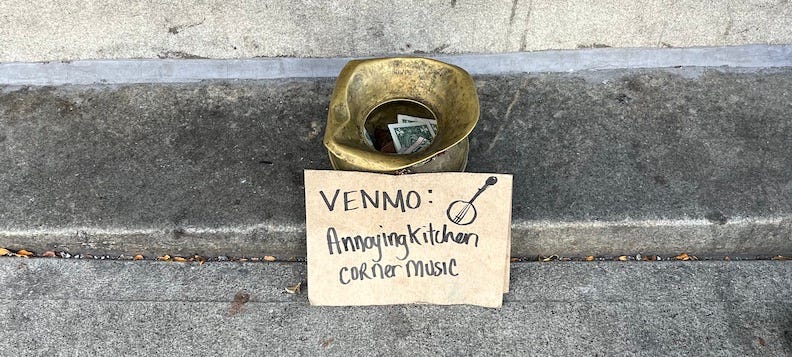A few weeks ago, I came home to find a traveling street musician named Jerry playing excellent banjo on the stoop of my building.
It’s easier for me, and probably most people, to give a busker money than someone plying their trade with only a cardboard sign. Indeed, there were already a few dollars and coins in the antique brass spittoon at Jerry’s feet. And a small folded sign in front of it: “Venmo accepted.” And his User Name: “AnnoyingKitchenCornerMusic.”
I’d been wondering how my friends on the street would continue to fundraise as people increasingly stop carrying cash. I had some vague memory of reading about homeless people in New York taking contributions cash-lessly. But face-to-face with the phenomenon in my small town, I found the idea a little disconcerting. It seemed too corporate—even for a musician doing business on the street. It made what is usually a personal (albeit sometimes uncomfortable) interaction feel impersonal and transactional.
So, instead of using Venmo to support “AnnoyingKitchenCornerMusic,” I went upstairs, grabbed two beers and a $5 bill, and went down to give Jerry the third-degree. I learned that he’s originally from Maryland, never went to college, is 31 although he looks 21, travels around the country in a small school bus, and makes his living by playing on the street and picking up odd jobs. He gave me a brief rundown of towns that are good for street musicians—Camden, Maine sticks in my mind—and that on a good day he can make $80. Made me want to go to Camden.
I asked him about how my friends on the street could get donations since they don’t have bank accounts. He explained that there are cash apps available, although to use them you need a phone—and can only use them to buy things online.
That got me thinking…always a dangerous development. Like maybe the drop-in center could give people cards with a QR code for the contributor to scan and enter the amount they wanted to go in the person’s account at the drop-in center. Or instead of individual stores having “gift cards,” there could be “Drop-In Center Gift Cards” that that local businesses accepted as cash. Or a community bank could give free accounts to people who aren’t able to make the minimums. Remember, it takes a lot to save money for an apartment and the street is a risky place to carry a lot of cash around.
At least the local dealer wouldn’t be able to take the cards. Wait, why not? Sure they could. Ultimately, everything can be coin, even a cupcake.
My head was starting to hurt.
I’ve always felt that the cardboard sign thing with illegible writing isn’t an ideal marketing tactic. One of the goals of marketing is to make people feel good about doing business with you. This applies to someone on the street asking for money as much as it does to Geico. I knew a guy once who, instead of sticking out his thumb to hitchhike, cut a big piece of cardboard in the shape of a hand with its thumb up and put it on a stick.
A while ago I had the idea that the shelter could give Buddhist-type robes and begging bowls to people living on the street. It might be a more effective fund-raising tactic in our very liberal town than standing with a cardboard sign. I know that idea is on the spectrum between flippant, enabling, and insulting. But, from another perspective, holding a cardboard sign for hours a day is a kind of meditation.
And my friends don’t even have a temple or monastery to return to at night.






Good one, I agree. Offering solutions gives the subject a boost.
This is a good one, Dave. This thread is provocative, thoughtful, and thought inducing.